Ahmed III
Ahmed III (Ottoman Turkish: احمد ثالث, Aḥmed-i sālis) (30 December 1673 – 1 July 1736) was Sultan of the Ottoman Empire and a son of Sultan Mehmed IV (r. 1648–87). His mother was Gülnuş Sultan, originally named Evmenia Voria, who was an ethnic Greek.[1][2][3][4][5] He was born at Hacıoğlu Pazarcık, in Dobruja. He succeeded to the throne in 1703 on the abdication of his brother Mustafa II (1695–1703).[6] Nevşehirli Damat İbrahim Pasha and the Sultan's daughter, Fatma Sultan (wife of the former) directed the government from 1718 to 1730, a period referred to as the Tulip Era.
| Ahmed III احمد ثالث | |||||
|---|---|---|---|---|---|
| Sultan of the Ottoman Empire Kayser-i Rûm Custodian of the Two Holy Mosques Ottoman Caliph | |||||
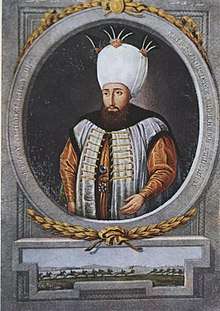 | |||||
| 23rd Ottoman Sultan (Emperor) | |||||
| Reign | 22 August 1703 – 1 October 1730 | ||||
| Predecessor | Mustafa II | ||||
| Successor | Mahmud I | ||||
| Born | 30 December 1673 Hacıoğlu Pazarcık, Ottoman Empire (present day Dobrich, Bulgaria) | ||||
| Died | 1 July 1736 (aged 62) Constantinople, Ottoman Empire (present day Istanbul, Turkey) | ||||
| Burial | Tomb of Turhan Sultan, Istanbul | ||||
| Consorts | Mihrişah Kadın Şermi Kadın among others | ||||
| Issue | see below | ||||
| |||||
| Dynasty | Ottoman | ||||
| Father | Mehmed IV | ||||
| Mother | Gülnuş Sultan | ||||
| Religion | Sunni Islam | ||||
| Tughra | |||||
The first days of Ahmed III's reign passed with efforts to appease the janissaries who were completely disciplined. However, he was not effective against the janissaries who made him sultan. Çorlulu Ali Pasha, who Ahmed brought to the Grand Vizier, tried to help him in administrative matters, made new arrangements for the treasury and Sultan. He supported Ahmed in his fight with his rivals.
Early life and education
Sultan Ahmed was born on 30 December 1673. His father was Sultan Mehmed IV, and his mother was Gülnuş Sultan, originally named Evmenia.[7] His birth occurred in Hacıoğlupazarı, where Mehmed stayed to hunt on his return from Poland in 1673, while Gülnuş was pregnant at that time.[8] In 1675, He and his brother, Prince Mustafa (future Mustafa II) were circumcised. During the same ceremony their sisters Hatice Sultan and Fatma Sultan were married to Musahip Mustafa Pasha and Kara Mustafa Pasha respectively.[9] The celebrations lasted 20 days.[10]
He grew up in the Edirne Palace. His schooling began during one of the sporadic visits of the court to Istanbul, following a courtly ceremony called bad-i basmala, which took place on 9 August 1679 in the Istavroz Palace. He was brought up in the imperial harem in Edirne with a traditional princely education, studying the Qur’an, the hadiths (traditions of Prophet Muhammad), and the fundamentals of Islamic sciences, history, poetry and music under the supervision of private tutors.[11] One of his tutors was chief mufti Feyzullah Efendi.[12]
Ahmed was apparently curious and intellectual in nature, spending most of his time reading and practising calligraphy. The poems that he wrote manifest his profound knowledge of poetry, history, Islamic theology and philosophy. He was also interested in calligraphy, which he had studied with the leading court calligraphers, primarily with Hafız Osman Efendi (died 1698), who influenced his art immensely, and, therefore, practiced it because of the influence of his elder brother, the future Sultan Mustafa II, who also became a notable calligrapher.[11]
During his princehood in Edirne, Ahmed made friends with a bright officer-scribe, Ibrahim, from the city of Nevşehir, who was to become one of the outstanding Grand Viziers of his future reign. From 1687, following the deposition of his father, he lived in isolation for sixteen years in the palaces of Edirne and Istanbul. During this period he dedicated himself to calligraphy and intellectual activities.[13][14]
Reign
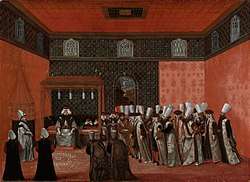
Accession
The Edirne event which held from 19 August to 23 August happened in Edirne, Mustafa was deposed and his brother Ahmed succeeded to the throne on 22 August 1703 and announced his withdrawal of the throne. The first Friday salute was held in Bayezid Mosque.[15] Istanbul, which has been out of control for a long time, was not a peaceful and safe environment. As the confusions, arrests and executions continued, theft and robbery incidents were common. [16]
Fındıklılı Mehmed Ağa welcomed the new sultan at the Harem gate on the Hasoda side, entered the arm, brought him to the Cardigan-i Saadet Department and placed them on the throne, and were among the first to pay him. [17]
As part of the fief system renovation programme implemented, he had the land law reorganized in 1705. Due to his support of these new laws, Ahmed was given the title 'law-giver', a title given to three early sultans, Bayezid II (r.1481-1512), Selim I (r.1512-1520) and Suleyman the Magnificent (r.1520-1566). In the first three years of his reign, Ahmed appointed four Grand Viziers, one after the other. However, the government only gained stability after the appointment of Çorlulu Ali Pasha in May 1706.[18]
Russo-Ottoman War of 1710–11
Ahmed III cultivated good relations with France, doubtless in view of Russia's menacing attitude. He afforded refuge in Ottoman territory to Charles XII of Sweden (1682–1718) after the Swedish defeat at the hands of Peter I of Russia (1672–1725) in the Battle of Poltava of 1709.[19] In 1710 Charles XII convinced Sultan Ahmed III to declare war against Russia, and the Ottoman forces under Baltacı Mehmet Pasha won a major victory at the Battle of Prut. In the aftermath, Russia returned Azov back to the Ottomans, agreed to demolish the fortress of Taganrog and others in the area, and to stop interfering in the affairs of the Polish–Lithuanian Commonwealth.
Forced against his will into war with Russia, Ahmed III came nearer than any Ottoman sovereign before or since to breaking the power of his northern rival, whose armies his grand vizier Nevşehirli Damat İbrahim Pasha succeeded in completely surrounding at the Pruth River Campaign in 1711.[6] The subsequent Ottoman victories against Russia enabled the Ottoman Empire to advance to Moscow, had the Sultan wished. However, this was halted as a report reached Istanbul that the Safavids were invading the Ottoman Empire, causing a period of panic, turning the Sultan's attention away from Russia.
Wars with Venice and Austria
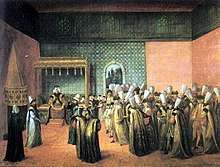
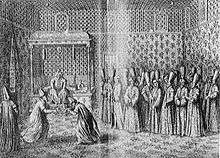
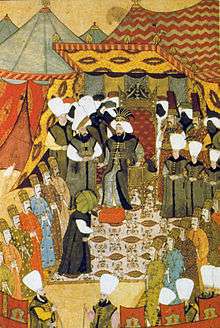
On 9 December 1714, war was declared on Venice, and an army under Silahdar Damat Ali Pasha's command, [18] the Ottomans managed to recover the whole Morea (Peloponnese) from Venice through coordinated operations of the army and navy.[20]
This success alarmed Austria and in April 1716, Emperor Charles VI provoked the Porte into a declaration of war. The unsuccessful battle, also commanded by Silahdar Ali Pasha, ended with the treaty of Passarovitz, signed on 21 July 1718, according to which Belgrade, Banat, and little Wallachia were ceded to Austria. This failure was a real disappointment for Ahmed and after the bad conditions imposed by this treaty, Istanbul's economy suffered from increased inflation and all of its attendant evils.[21]
Ibrahim Pasha who was the second leading figure of the empire after Ahmed had joined the Morea campaign in 1715, and was appointed as the city of Nish's minister of finance the following year. This post helped him realize the downturn of the state's finances and, due to his insight of this sensitive financial situation he avoided war as much as possible during his vizierate. Ibrahim Pasha's policy of peace suited Ahmed as well since he had no wish to lead any military campaigns, in addition to the fact that his interest in art and culture made him reluctant to leave his Istanbul.[21]
Character of Ahmed's rule
While shooting competitions were held in Okmeydanı with the idea of increasing the morale of the soldiers and the people, a new warship was launched in Tersane-i Amir. He tried three grand viziers at short intervals. Instead of Hasan Pasha, he appointed Kalaylikoz Ahmed Pasha on 24 September 1704, and Baltacı Mehmed Pasha on 25 December 1704. [16] It was a great pleasure that the ambassadors of Iran and Austria, who came from 1706–1707. In 1707, the conspiracy led by Eyüplü Ali Ağa was unearthed to bring the sultan off the throne. Necks were cut in front of the Bab-I-Hümayun . Ahmed III left the finances of the Ottoman Empire in a flourishing condition, which had remarkably been obtained without excessive taxation or extortion procedures. He was a cultivated patron of literature and art, and it was in his time that the first printing press authorized to use the Arabic or Turkish languages was set up in Istanbul, operated by Ibrahim Muteferrika (while the printing press had been introduced to Constantinople in 1480, all works published before 1729 were in Greek, Armenian, or Hebrew).
It was in this reign that an important change in the government of the Danubian Principalities was introduced: previously, the Porte had appointed Hospodars, usually native Moldavian and Wallachian boyars, to administer those provinces; after the Russian campaign of 1711, during which Peter the Great found an ally in Moldavia Prince Dimitrie Cantemir, the Porte began overtly deputizing Phanariote Greeks in that region, and extended the system to Wallachia after Prince Stefan Cantacuzino established links with Eugene of Savoy. The Phanariotes constituted a kind of Dhimmi nobility, which supplied the Porte with functionaries in many important departments of the state.
Relations with the Mughal Empire
Jahandar Shah
In the year 1712, the Mughal Emperor Jahandar Shah, the grandson of Aurangzeb sent gifts to the Ottoman Sultan Ahmed III and referred to himself as the Ottoman Sultan's devoted admirer.[22]
Farrukhsiyar
The Mughal Emperor Farrukhsiyar a grandson of Aurangzeb, is also known to have sent a letter to the Ottomans but this time it was received by the Grand Vizier Nevşehirli Damad Ibrahim Pasha providing a graphic description of the efforts of the Mughal commander Syed Hassan Ali Khan Barha against the Rajput and Maratha rebellion.[23]
Deposition
Sultan Ahmed III had become unpopular by reason of the excessive pomp and costly luxury in which he and his principal officers indulged; on 20 September 1730, a mutinous riot of seventeen Janissaries, led by the Albanian Patrona Halil, was aided by the citizens as well as the military until it swelled into an insurrection in front of which the Sultan was forced to give up the throne.
Ahmed voluntarily led his nephew Mahmud I (1730–54) to the seat of sovereignty and paid allegiance to him as Sultan of the Empire. He then retired to the Kafes previously occupied by Mahmud and died at Topkapı Palace after six years of confinement.
Architecture
Ahmed III built water claps, fountain and park waterfalls. Ahmed, who built three libraries, one inside the Topkapı Palace, and one of the famous lines of his period. Ahmed was a master in the writings on plates. Some plates and inscriptions have survived. The “Basmala” at the Topkapi Palace apartment door with its plates in the Üsküdar Yeni Mosque are among them.[24]
Topkapı Palace and its buildings have been the subject of many researches and publications. Among these researches, many different scope studies are also noticed together with postgraduate theses. Consequently, they provide rich information about the palace, which provides a long list of highly qualified scientific articles and books, guides and brochures promoting the palace and museum. However, Topkapi Palace and its units still have aspects to be explored and details to be discussed. Among them Ahmed III library can also be counted. [25]
A library was built by Ahmed in 1724-25 to the right of the porch in front of the tomb. The structure, which has stone-brick alternate meshed walls, is square-shaped and covered with a flattened dome with an octagonal rim, which is provided with pendants. There are original pen works left in the pendants and dome of the library. [26]
Disasters
In 1714, an Egyptian galleon standing near the Gümrük (Eminönü) Pier caught fire and burned, and two hundred people died.[27]
Fire of 1718
While Nevşehirli Damat Ibrahim Pasha continued his preparations for return to Istanbul, a fire broke out in Istanbul. Unkapanı, Azapkapı, Zeyrek, Fatih, Saraçhane, Horhor, Etmeydanı, Molla Gürani, Altımermer, Ayazma Gate, Kantarcılar, Vefa, Vez neciler, Old Rooms, Acemioğlanlar Barracks, Çukur Çeşme, Langa, Davudpaşa districts were burned from the fire.[28]
Earthquake of 1719
However, this festivity went astringent as it came just after the three-minute big earthquake on 14 May 1719. While the city walls of Istanbul were destroyed in the earthquake, 4000 people died in Izmit and Yalova was destroyed. After the earthquake, reconstruction work started in Istanbul. The most meaningful element that reflects the cultural aspect or weight of these works until today is the Topkapı Palace Enderun Library, which was built that year. A rich foundation was established for this institution, which is also known as Sultan Ahmed-i Salis Library, which has a face-to-face with its architectural and valuable manuscripts.[29]
Family
Consorts
Ahmed had twelve consorts:
- Emetullah Kadın (died 1739, buried in Eyüp Sultan Mosque);
- Rukiye Kadın;
- Mihrişah Kadın (died 1732, buried in New Mosque, Istanbul);
- Şermi Kadın (died 1732, buried in New Mosque, Istanbul);
- Ümmügülsüm Kadın (died 1768, buried in New Mosque, Istanbul);
- Hatice Kadın (died 1722, buried in New Mosque, Istanbul);
- Fatma Kadın (died 1732, buried in New Mosque, Istanbul);
- Emine Muslihe Kadın (died 1750, buried in New Mosque, Istanbul);
- Hanife Kadın (died 1750, buried in New Mosque, Istanbul);
- Zeynep Kadın (died 1757, buried in New Mosque, Istanbul);
- Şahin Kadın (died 1732, buried in New Mosque, Istanbul);
- Hace Hanım Kadın;
Issue
Ahmed had forty five children, of whom fifteen, six sons and nine daughters survived to adulthood:
- Fatma Sultan (22 September 1704[30] – 4 January 1733, buried in New Mosque, Istanbul), with Emetullah;
- Şehzade Mehmed (25 November 1705[31] – 20 June 1706, buried in New Mosque, Istanbul);[32]
- Şehzade Isa (23 February 1706[33] – Tersane Garden, 25 May 1706, buried in New Mosque, Istanbul);[34]
- Şehzade Ali (18 June 1706[32] – Karaağaç Garden, 12 September 1706, buried in New Mosque, Istanbul);[35]
- Hatice Sultan (21 January 1707[36] – 8 December 1708, buried in New Mosque, Istanbul);[37]
- Rukiye Sultan (2 May 1707[38] – 4 May 1708, buried in New Mosque, Istanbul);[39]
- Şehzade Selim (8 September 1707[40] –5 May 1708, buried in New Mosque, Istanbul);[41]
- Şehzade Murad (4 February 1708[42] – 1 April 1708, buried in New Mosque, Istanbul);[43]
- Ümmügülsüm Sultan (7 February 1708[42] – 1732, buried in New Mosque, Istanbul),[44] twin with Zeynep;
- Zeynep Sultan (7 February 1708[42] – 5 October 1708, buried in New Mosque, Istanbul), twin with Ümmügülsüm;[45]
- Şehzade Abdülmelik (12 December 1709[46] – 19 March 1710, buried in New Mosque, Istanbul);[47]
- Zeynep Sultan (5 January 1710[46] – Tersane Garden, 1 August 1710, buried in New Mosque, Istanbul);[48]
- Şehzade Suleiman (25 August 1710[49] – 11 December 1732, buried in New Mosque, Istanbul), with Mihrişah;
- Hatice Sultan (4 October 1710[50] – 1738, buried in New Mosque, Istanbul), with Rukiye;
- Atike Sultan (29 March 1712[51] – 2 April 1738, buried in New Mosque, Istanbul);
- Rukiye Sultan (7 March 1712[51] – 28 October 1714, buried in New Mosque, Istanbul);[39]
- Şehzade Mehmed (17 October 1712[52] – 15 July 1713, Edirne Palace, buried in Darülhadis Mosque);[53][54]
- Zeynep Sultan (8 April 1714[55] – 1715, Edirne Palace, buried in Darülhadis Mosque);[54]
- Zeynep Sultan (1715 – 25 March 1774, buried in Zeynep Sultan Mosque);
- Şehzade Selim (20 April 1715, Edirne Palace[56] – 1715, Edirne Palace, buried in Darülhadis Mosque),[54] twin with Saliha, with Hace Hanım;
- Saliha Sultan (20 April 1715, Edirne Palace[56] – 11 October 1778, buried in Eyüp Cemetery), twin with Selim, with Hace Hanım;
- Şehzade Mehmed (1 January 1717[57] – 22 December 1756, buried in New Mosque, Istanbul), Crown Prince from 1754 to 1756;
- Sultan Mustafa III (28 January 1717[57] – 21 January 1774), Sultan of the Ottoman Empire from 1757 to 1774, with Mihrişah;
- Şehzade Selim (6 December 1718[58] – died young, buried in New Mosque, Istanbul);
- Şehzade Bayezid (4 October 1718[59] – 25 January 1771, buried in New Mosque, Istanbul), Crown Prince from 1757 to 1771;
- Ayşe Sultan (24 November 1718[60] – 3 October 1776, buried in New Mosque, Istanbul), with Muslihe;
- Ümmüseleme Sultan (died 26 December 1718, buried in New Mosque, Istanbul);[60]
- Hatice Sultan (born 19 November 1719[61] –2 August 1720, buried in New Mosque, Istanbul);[62]
- Reyhane Sultan (died 12 December 1719, buried in New Mosque, Istanbul);[61]
- Şehzade Abdullah (18 December 1719 – 19 December 1719, buried in New Mosque, Istanbul);[63]
- Emetullah Sultan (23 December 1719 – 5 February 1720, buried in New Mosque, Istanbul);[63]
- Rukiye Sultan (died 20 January 1720, buried in New Mosque, Istanbul);[63]
- Şehzade Ibrahim (9 January 1721[64] – 5 April 1721, buried in New Mosque, Istanbul);[65]
- Şehzade Numan (22 February 1723[66] – 29 December 1764, buried in New Mosque, Istanbul);
- Emetullah Sultan (29 September 1723[67] – 28 July 1724, buried in New Mosque, Istanbul);[68]
- Naile Sultan (15 February 1725[69] – 10 December 1726, buried in New Mosque, Istanbul);[70]
- Sultan Abdul Hamid I (20 March 1725[71] - 7 April 1789), Sultan of the Ottoman Empire from 1774 to 1789, with Şermi;
- Nazife Sultan (31 May 1725[72] – died young, buried in New Mosque, Istanbul);
- Esma Sultan (14 March 1726[73] – 13 August 1788), with of Hanife;
- Sabiha Sultan (26 November 1726 – 3 December 1726, buried in New Mosque, Istanbul);[74]
- Rebia Sultan (28 October 1727[75] – 4 April 1728, buried in New Mosque, Istanbul);[76]
- Şehzade Seyfeddin (3 February 1728[77] – 1732, buried in New Mosque, Istanbul), with Mihrişah; [78]
- Zübeyde Sultan (29 March 1728[79] – 4 June 1756), with Muslihe;
- Ümmüseleme Sultan (died 1732, buried in New Mosque, Istanbul);[44]
- Emine Sultan (died 1732, buried in New Mosque, Istanbul);[44]
Death
Ahmed lived in Kafes of the Topkapi Palace for six years following his deposition. Where he fall ill and died on 1 July 1736. He was buried in his grandmother's tomb in Turhan Sultan Mausoleum in New Mosque, at Eminönü in Istanbul.[80]
In fiction
In Voltaire's Candide, the eponymous main character meets the deposed Ahmed III on a ship from Venice to Constantinople. The Sultan is in the company of five other deposed European monarchs, and he tells Candide, who initially doubts his credentials:
I am not jesting, my name is Achmet III. For several years I was Sultan; I dethroned my brother; my nephew dethroned me; they cut off the heads of my viziers; I am ending my days in the old seraglio; my nephew, Sultan Mahmoud, sometimes allows me to travel for my health, and I have come to spend the Carnival at Venice."
This episode was taken up by the modern Turkish writer Nedim Gürsel as the setting of his 2001 novel Le voyage de Candide à Istanbul.
In fact, there is no evidence of the deposed Sultan being allowed to make such foreign travels, nor did Voltaire (or Gürsel) assert that it had any actual historical foundation.
See also
- Fountain of Ahmed III
- Fountain of Ahmed III (Üsküdar)
- Ibrahim Muteferrika
- Esma Sultan, daughter of Ahmed III
References
- Freely, John (2001). The lost Messiah. Viking. p. 132. ISBN 0-670-88675-0.
He set up his harem there, his favourite being Rabia Giilniis Ummetiillah, a Greek girl from Rethymnon on Crete
- Bromley, J. S. (1957). The New Cambridge Modern History. University of California: University Press. p. 554. ISBN 0-521-22128-5.
the mother of Mustafa II and Ahmed III was a Greek
- Sardo, Eugenio Lo (1999). Tra greci e turchi: fonti diplomatiche italiane sul Settecento ottomano. Consiglio nazionale delle ricerche. p. 82. ISBN 88-8080-014-0.
Their mother, a Greek, lady named Rabia Gülnûş, continued to wield influence as the Valide Sultan - mother of the reigning sultan
- Library Information and Research Service (2005). The Middle East. Library Information and Research Service. p. 91.
She was the daughter of a Greek family and she was the mother of Mustafa II (1664–1703), and Ahmed III (1673–1736).
CS1 maint: uses authors parameter (link) - Baker, Anthony E - Freely, John (1993). The Bosphorus. Redhouse Press. p. 146. ISBN 975-413-062-0.
The Valide Sultan was born Evmania Voria, daughter of a Greek priest in a village near Rethymnon on Crete. She was captured by the Turks when they took Rethymnon in 1645.
CS1 maint: uses authors parameter (link) -

- Baker, Anthony E (1993). The Bosphorus. Redhouse Press. p. 146. ISBN 975-413-062-0.
The Valide Sultan was born Evmania Voria, daughter of a Greek priest in a village near Rethymnon on Crete. She was captured by the Turks when they took Rethymnon in 1645.
- Sakaoğlu 2015, p. 295.
- Uluçay 2011, p. 110.
- Sakaoğlu 2015, p. 286.
- Keskiner 2012, p. 47.
- Hathaway, Jane (August 30, 2018). The Chief Eunuch of the Ottoman Harem: From African Slave to Power-Broker. Cambridge University Press. p. 133. ISBN 978-1-107-10829-5.
- Keskiner 2012, p. 47-8.
- Sakaoğlu 2015, p. 296.
- Sakaoğlu, Necdet (2015) Bu mülkün sultanları
- Sakaoğlu 2015, p. 297.
- Türkal 2013, p. 31.
- Keskiner 2012, p. 56.
- Chisholm 1911.
- Ágoston & Masters 2009, p. 25.
- Keskiner 2012, p. 57.
- Farooqi, N.R. (1989). Mughal-Ottoman relations: a study of political & diplomatic relations between Mughal India and the Ottoman Empire, 1556-1748. Idarah-i Adabiyat-i Delli.
- Mughal-Ottoman relations: a study of political & diplomatic relations ... - Naimur Rahman Farooqi. Books.google.com. 1989. Retrieved 2012-04-29.
- Sakaoğlu 2015, p. 307.
- Uysal 2019, p. 333.
- "YENİCAMİ KÜLLİYESİ İstanbul'da XVI. yüzyılın sonlarında inşasına başlanan ve XVII. yüzyılın ikinci yarısında tamamlanan külliye". İslam Ansiklopedisi. Retrieved 11 April 2020.
- Sakaoğlu 2015, p. 299.
- Sakaoğlu 2015, p. 300.
- Sakaoğlu 2015, p. 301.
- Topal 2001, p. 668.
- Topal 2001, p. 680.
- Topal 2001, p. 686.
- Topal 2001, p. 682.
- Topal 2001, p. 685.
- Topal 2001, p. 687.
- Topal 2001, p. 689.
- Topal 2001, p. 697.
- Topal 2001, p. 691.
- Topal 2001, p. 821.
- Topal 2001, p. 695.
- Topal 2001, p. 706.
- Topal 2001, p. 698.
- Topal 2001, p. 705.
- Efendi, Subhi Mehmed; Aydıner, Mesut; Şâkir, Hüseyin (2007). Subhî tarihi: Sâmî ve Şâkir tarihleri ile birlikte 1730-1744 (inceleme ve karşılaştırmalı metin). Kitabevi. p. 178.
- Topal 2001, p. 708.
- Topal 2001, p. 723.
- Topal 2001, p. 725.
- Topal 2001, p. 729.
- Topal 2001, p. 731.
- Topal 2001, p. 733.
- Topal 2001, p. 769.
- Topal 2001, p. 770.
- Topal 2001, p. 797.
- Onur, Oral (1994). Edirne türbeleri ve evlad-ı Fatihan mezarları. O. Onur. p. 27.
- Topal 2001, p. 811.
- Topal 2001, p. 831.
- Topal 2001, p. 867.
- Topal 2001, p. 890.
- Topal 2001, p. 898.
- Topal 2001, p. 900.
- Topal 2001, p. 909.
- Topal 2001, p. 914.
- Topal 2001, p. 910.
- Topal 2001, p. 931.
- Topal 2001, p. 933.
- Aktaş 2008, p. 13-4.
- Aktaş 2008, p. 32.
- Aktaş 2008, p. 80.
- Aktaş 2008, p. 111.
- Aktaş 2008, p. 205.
- Aktaş 2008, p. 112.
- Aktaş 2008, p. 125.
- Aktaş 2008, p. 164-5.
- Aktaş 2008, p. 199.
- Sakaoğlu 2008, p. 325.
- Aktaş 2008, p. 258.
- Aktaş 2008, p. 255-6.
- Haskan 2001, p. 1167.
- Aktaş 2008, p. 257.
- Sakaoğlu 2015, p. 306.
Sources
- This article incorporates text from the History of Ottoman Turks (1878)
- Aktaş, Ali (2008). ÇELEBİZÂDE ÂSIM TARİHİ: Transkripsiyonlu metin.
- Topal, Mehmet (2001). Silahdar Findiklili Mehmed Agha Nusretnâme: Tahlil ve Metin (1106-1133/1695-1721).
- Sakaoğlu, Necdet (2015). Bu Mülkün Sultanları. Alfa Yayıncılık. ISBN 978-6-051-71080-8.
- Uysal, Zekiye (2019). Topkapı Sarayındaki III. Ahmet Kütüphanesi’nin Alçı Bezemeleri.
- Türkal, Merve (2013). Silahdar Findiklili Mehmed Ağa'nin Hayati ve eserleri (1658 / 1726-27).
External links
![]()
![]()
Ahmed III House of Osman Born: 30 December 1673 Died: 1 July 1736[aged 62] | ||
| Regnal titles | ||
|---|---|---|
| Preceded by Mustafa II |
Sultan of the Ottoman Empire 22 August 1703 – 1 October 1730 |
Succeeded by Mahmud I |
| Sunni Islam titles | ||
| Preceded by Mustafa II |
Caliph of the Ottoman Caliphate 22 August 1703 – 1 October 1730 |
Succeeded by Mahmud I |

